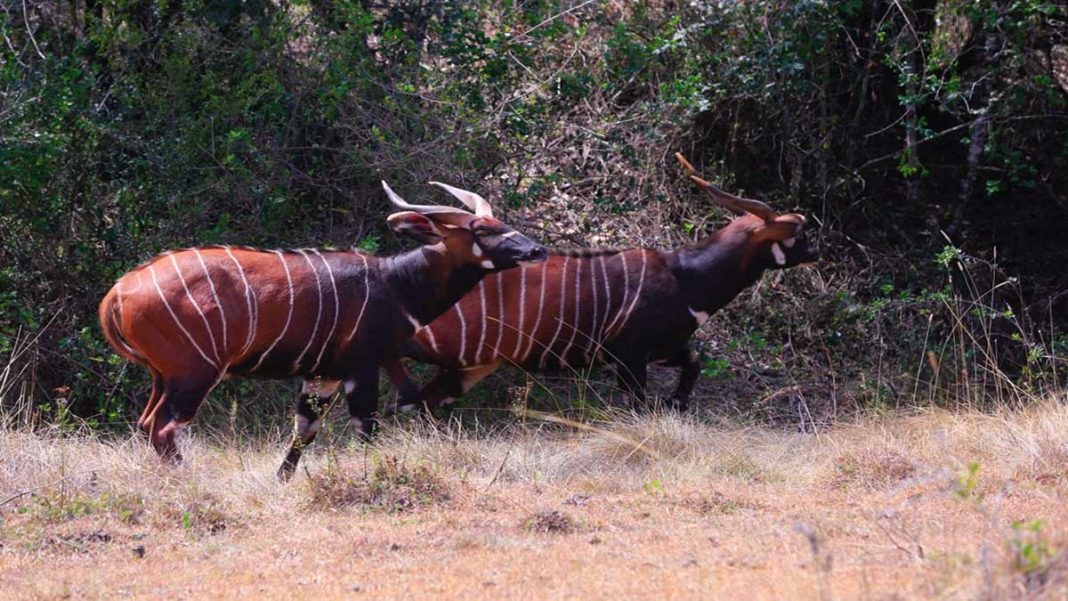Due to massive poaching, only 20 white rhinos were left in South Africa in 1895. Today, 20,000 rhinos are native to South Africa, the largest concentration of this endangered species in the world. It is evidence that positive results can be achieved by focused conservation.
According to the world’s leading scientists and ecologists, one out of five animal species on earth is now facing extinction, with estimates expected to rise to 50% by the end of the century unless immediate action is taken.
we are on target to witness a 67% reduction in global stocks of humans, birds, rodents, amphibians and reptiles relative to 1970 figures by 2020.
WWF’s Living Planet Report 2016
Threatened animals such as the rhino can make the headlines, but the lesser-known animals are given little attention. Another such species is the seriously endangered Mountain Bongo. In the early 1980s, Kenyans who were raised around Elgon Mount, Mt Kenya, and Rift Valley sections may remember the majestic antelopes they saw.Considered to be the most beautiful antelope, bongos are found in its natural habitat only in Kenya and about 100 remain in the wilderness.
In the last 50 years, wild populations have declined mainly as a result of unregulated harvesting, grazing, habitat loss, uncontrolled deforestation and pathogens such as cattle ravine that are expected to have reduced their numbers sharply in the 1890s and early 1930s.
The International Union for the Conservation of Nature (IUCN) Red List also allows it be critically endangered.
At the Mount Kenya Wildlife Conservancy (MKWC) just a month ago, global efforts to survive the critically endangered Mountain Bongo antelope received a boost after four births.
The births have renewed hope for the survival of the rare Mountain Bongo Antelope whose population of approximately 100 in the wild world is below the threshold of 250 mature individuals needed to make a genetically stable population.
Today, after the recent births, MKWC holds Mountain Bongo’s largest herd in the world now totalling 72. The conservancy runs a program of rehabilitation that breeds mountain bongos for reintroduction into their natural habitat. It is the world’s only conservation program in a semi-wild environment.
The Mount Kenya Wildlife Conservancy (MKWC), the fundraising arm that supports the ranch’s conservation programs, runs a breeding program aimed at increasing the number of these animals.
This is the only bongo breeding program of its kind in the world where in a semi-wild environment these animals are bred. The current 68 bongos population lives on 130-acres, divided into 14 paddocks, allowing the conservancy to separate incompatible breeding groups.
Given these concerted conservation efforts, the figure is well below the minimum number of adults making the population biologically viable, and we need to do more! MKWC has taken an integrated approach to providing Kenya with healthy and genetically diverse mountain bongo herds that can fully fend for current and former ranges in the wild.
The Conservancy hired the mountain communities to monitor and identify any anomalies. This paradigm has transcended community involvement in school curricula as the need for sustainability awareness from a young age is critical to fostering a balanced and optimistic community attitude towards environmental value.
Partnerships with the National Bongo Task Force, the Kenya Wildlife Service and the Kenya Forestry Service also boosted steady progress toward raising the Mountain Bongo population. However, the greater responsibility for conservation lies with the citizens beyond the government agencies.
Over the years, human activities have interfered with the natural habitats of the animals and hindered their conservation. The steady growth of the population puts pressure on some of the pristine wild habitats in Kenya. The search for timber, food and fuel has dealt a deadly blow to the once virgin wild habitats, particularly the destructive logging and charcoal burning trade.
Our natural resources are our inheritance; we owe the obligation of our children to preserve their heritage from all agents of destruction and extinction. We must ensure that every species in our country survives and continues.
Our children need to be educated to aspire beyond the instant gratification that poaching or deforestation brings; it is crucial to preserve and sustain. A lot is at stake; we have to stay committed. In August, the conservancy had four new births, showing that the product of hard work and planning is progress.
Through the extensive education program and collaborations of MKWC, they hope to increase understanding of the mountain bongo, increase their numbers and protect their natural habitats most importantly. We call on like-minded Kenyans to join the cause of conservation in order to save the extinct animals. No small effort is going to waste; when we come together, everything counts!

